VODKA

Stolichnaya vodka Vodka has traditionally been made by processing equal amounts of alcohol and water with some trace additives to soften the taste and then filtering the alcohol water mixture through carbon. The word vodka is a diminutive form of the Russian word for water. It was coined in the late 19th century by the famous Russian chemist Dmitri Ivanovich Mendeleev, who formulated the Periodic Law, classifying elements according to their atomic numbers. Before that time vodka was simply known as “grain wine.” [Source: Victor Erofeyev, The New Yorker, December 16, 2002]
Victor Erofeyev wrote in The New Yorker, “To this day, there are probably more euphemisms for vodka than for anything other than the male sex organ. Its aliases range from “hot water,” “the mono-polka,” “the bubble,” “crankshaft,” “the bitter stuff,” and “the white stuff” to the classic Soviet “half liter” and “quarter bottle” (also known as a “daughter”).
The alcohol used in vodka is usually distilled from wheat or rye not potatoes like many people believe. It can also be made of corn, sugar cane, beet roots, grapes, vegetables, fruits, practically anything that ferments, even potatoes. One of the unusual things about the processing of vodka is that when the alcohol and water are mixed the mixture contracts (500 liters of water plus 500 liters of alcohol produces 941 liters of vodka). Additives include sugar (used in Stolichnaya) and sodium bicarbonate (used in Moskovaya).
Websites and Resources: Drink Focus drinkfocus.com ; Alcoholic Drink.net alcoholicdrinks.net ; Wikipedia article Wikipedia ;International Center for Alcohol Policies Tables icap.org/table ; International Center for Alcohol Policies icap.org ; History of Alcoholic Beverages potsdam.edu/hansondj ; History of Alcohol nicks.com.au ; Alcohol in Ancient Egypt thekeep.org/~kunoichi/kunoichi/themestream/egypt_alcohol ;
Vodka in Russia
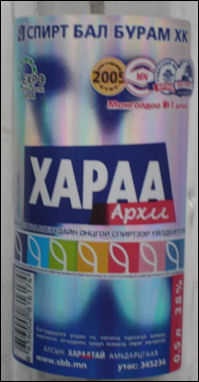
Mongolian vodka According to some studies a typical Russian man drinks 180 bottles of vodka a year, or one every two days. In Russia, vodka is very cheap, about $1 for half a liter, and greatly cherished. One Moscow liquor store owner said, "In our country, vodka is a purchase of the highest importance. Russians will never skimp on vodka — they'll just eat less."
Peter Baker wrote in the Washington Post, "Many Russians ascribe medicinal, almost supernatural qualities to vodka. Parents soak cotton balls in vodka and dab them on children to bring down a fever or ease an earache. Vodka with pepper is prescribed for an adult cold; vodka with salt is for an upset stomach. Some nuclear scientist even drank it protect themselves from radiation poisoning."
Erofeyev, an esteemed Russian writer, wrote in The New Yorker, “It seems to punch a hole directly in the subconscious, setting off a range of odd gestures and facial expressions. Some people wring their hands, some grin idiotically or snap their fingers; others sink into sullen silence. But no one, high or low, is left indifferent. More than by any political system, we are all held hostage by vodka. It menaces and it chastises, it demand sacrifices. It is both a catalyst of procreation and its scourge. It dictates who is born and who dies. In short, vodka is the Russian god.”
In the United States, vodka consumption grew in the 1990s and 2000s. More than 100 new vodkas — including some high-end varieties in very fancy bottles — were introduced between 1998 and 2002. In 2003 it surpassed whiskey as the most popular liquor in the U.S.
Origins of Vodka
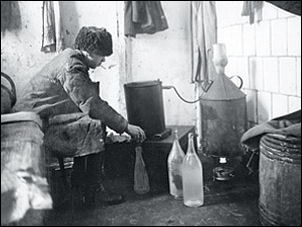
home still The origin of vodka is unclear. Both Russians and Poles claim they invented it. According to a Soviet historians hired to look into the matter in the 1970s, vodka was first produced by monks at the Chudov Monastery in the Kremlin in the late 15th century. Their first concoctions were made with alcohol imported from Genoa through the Crimean port of Feodosiya. Later is was made with grain alcohol made from locally grown rye or wheat and spring water. Many dismiss this version of events as too politically self serving.
Vodka may have invented as early as the 900s. Originally made in home stills, it is believed to have first been concocted as a disinfectant and a treatment for wounds. For many years it was used in medicines and cosmetics as well as for drinking. For centuries vodka was known as bread wine or “burnt wine.” Flavored vodkas dates back to around the 13th century when roots, honey, herbs and botanical essences were added to make raw just-out-of-the still vodka more palatable.
Before vodka became popular the drink of choice was honey-derived mead. It was drunk primarily during festivals and gave birth to the term of “revelry.”
Early History of Vodka in Russia

Russian alcohol stamp The founder of the Russian Vodka Museum in St. Petersburg told the Washington Post, "The whole history of Russian culture is tied to vodka." In the early days vodka was often made with wood alcohol, which gives a smell like kerosene, and was sold in buckets.
By the early 16th century, vodka drinking was enormously popular. Most of the vodka was produced by local tavern owners who became very rich at the expense of their customers. By the mid 17th century the consumption of vodka had gotten so out of hand that a third of the male population was deeply in debt to the taverns and many farmers were too drunk to cultivate their land. The state took over and monopolized the sale of the drink.
In the mid 17th century, the Orthodox Church declared that vodka was an invention of the devil and destroyed all the documents that related to vodka’s early history. The church’s and the government attempt to crackdown on vodkas drinking only drove the drink underground and encouraged people to make their own vodka at home, a custom that continues to this day.
Disturbed by the impact that vodka was having on his people, Czar Alexander III decided to improve the quality of vodka by hiring the famed Russian chemist Dmitri Mendeleev. Among the improvements he made were fixing the alcohol content at 40 percent and basing the amounts of water and alcohol used to make vodka on volume rather than weight.
Later History of Vodka in Russia
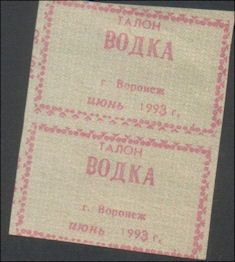
vodka stamp, 1993 The czarist, Soviet and post-Soviet governments have all been dependent on vodka taxes to stay afloat. At the beginning of 20th century, a third of the Russian Army was paid by a tax on the Smirov brand.
Lenin ended a prohibition on vodka enacted in World War I in the 1920s in a bid t boost his sagging popularity and introduced a kind vodka lite, with only 30 percent alcohol, called “rykobka “ . After Lenin’s death full-strength vodka was returned to the market and taxes on it help pay for the industrialization of the Soviet Union in the 1930s.
In World War II, the daily “commissar’s ration” of alcohol provided by the Stalin government was 100 hundred grams of vodka. Some Russians insist this ration — not the Katyusha rocket launchers Katyusha rocket launchers — is what allowed the Russians to turn the tide against the Nazis.
In the early 2000s, there was a nationwide panic when vodka production was disrupted when a new regulation required all bottle of vodka to carry a tax stamp were put in effect but the government had failed to produce enough stamps. A headline in Izvestia declared, "Vodka Factories Are at a Standstill All Across the Country." People responded to the news by rushing to stores and buying vodka by the case.
Drinking Vodka
Vodka has been described as a drink that is "odorless, tasteless, raw, fiery and even elegant” and a “neutral spirit, so treated after distillation with charcoal or other materials as to be robbed of its distinctive character, aroma, taste or color.” The best vodkas are supposed to pure and austere. In the West it is used in mixed drinks. In Russia and northern and eastern Europe it often consumed straight. In Russia it is regarded mainly as drink of the working classes. The middle class have traditionally considered it uncultured.
Erofeyev wrote: “Vodka is unlike other forms of alcohol in that there is not justifiable excuse for drinking it...It is an acrid and irritating drink. The Russian gulps his vodka down, grimacing and swearing and immediately reaches for something to “smooth it out.” The result not the process is what’s important. You might as well inject vodka into you veins as drink it.”
It has been said that drinking vodka helps Russians deal with the stress and wear and tear of their daily Iives in Russia. Many politicians and writers were heavy drinkers. The contemporary Siberian writer Evgeny Popov told The New Yorker, “Vodka makes it easier to think of literary plots.” Both Stalin and Peter the Great liked to give their guests more to drink than they could handle so to gain an edge on them.
Vodka Drinking Customs
 Vodka is often consumed straight and cold. It is swallowed in one gulp. No sipping allowed. Three glasses in a row — for starters. The night is not considered over until all the bottles of vodka are empty. Vodka is often consumed with a chaser, often juice. Many beer drinkers add a shot of vodka to their pints. During banquets, guests sometimes pour their vodka into their water glasses.
Vodka is often consumed straight and cold. It is swallowed in one gulp. No sipping allowed. Three glasses in a row — for starters. The night is not considered over until all the bottles of vodka are empty. Vodka is often consumed with a chaser, often juice. Many beer drinkers add a shot of vodka to their pints. During banquets, guests sometimes pour their vodka into their water glasses.
Traditionally the difference between a vodka and alcohol drinker was that the later waits until 5:00pm. Two-hour vodka lunches are popular with some people. Others drink vodka for breakfast. Sometimes it seems like the smell of stale vodka is on everyone's breath. Shops that sell vodka don't open until 2:00pm to keep workers from drinking it on the job and some people from drinking it all day.
A common superstition among vodka drinkers is to not eat after the first glass. But most Russians seem to ignore the custom and consume things like jellied meats, fish, salted gerkins and sauerkraut. A popular evening dish is vodka and water poured over a bowl of red berries. Many Russians become excited just by the thought of eating “pelmeni “ (dumplings) with their vodka.
Balancing a glass of vodka on one’s chin is a popular party trick. The Vodka Open, the first ever sport-drinking championship, was held in Moscow in 1997. The so called cultural event featured athletic exercises, workshops and tests as well as drinking contests.
Vodka Market
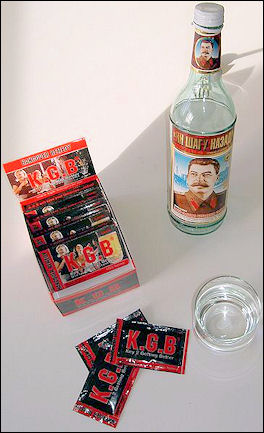
KGB hangover remedy Per capita vodka consumption in Russia is around 80 liters a year. Accurate figures on vodka consumption is difficult to come by because so many people buy untaxed black market vodka. It is estimated 30 to 60 percent of the vodka sold is illegally produced and no taxes are paid on it. Even so taxes from vodka sales put over $1 billion a year into the government’s coffers.
In Russia there are stores that specialize in selling nothing but vodka. In rural Russia vodka is as good as money. It is one of the most commonly bartered items for food and clothes and other things. Repairmen in the apartment buildings have traditionally demanded vodka before they would do any work.
Vodka is sold on the streets for 60 cents a shot in plastic containers like those for yoghurt. These are particularly popular as a warmer-upper in the winter. Government efforts to halt the trade have failed.
Types and Flavors of Vodka
Lighter ethyl vodka include Smirnoff (United States) and Absolute (Sweden). Among the medium bodied vodkas are Finlandia (Finland) and Canadian Iceberg (Canada). Stolichnaya (Russia) and Wyborowa (Poland) are considered robust vodkas.
Russian and Polish vodkas are considered the heartiest of the lot. Scandinavian countries are known for their lighter cocktail-friendly vodkas. Dutch vodka is regarded as sweet and gently textured.
Russian grain vodka brands, made from corn, rye or wheat, include Moskovskaya, Smirnoff Black, and Stolichnaya. Moskovskaya is flavored slightly with sodium bicarbonate. Stolichnaya is sweetened with sugar. Foreign brands of vodka like Absolute and Smirnoff are becoming more popular. Trendy brands in the United States include the French-made Grey Goose and the Dutch-made Ketel One.
Fruit flavored and even vegetable flavored vodkas are very popular in Russia. Flavors include banana, lemon, pepper, black currant, pepper, honey, citrus, raspberry, orange, cherry, honey, pineapple, melon, tangerine, raspberry, strawberry, peach and even beet, nuts, cinnamon, vanilla, chocolate, coffee, exotic spices, apple and pear leaves, juniper berries, cloves. You can get horseradish vodka. Vodka flavors are added after distillation.
Vodka Producers
Rosspirtprom is a government-run company that controls 40 percent of Russia’s vodka production. In the early 2000s, the director of Rosspirtprom, Sergei Zevenko said he had a $6 million price on his head and was even accompanied by bodyguards in his office. The government monopoly on vodka production is steadily being broken up.
Kristall is Russia's No. 1 vodka producer. It produces more than 70 brands of liquor. Their enormous factory in Moscow produces five million bottles a month. The Nazis bombed the factory because alcohol used for Molotov cocktails was produced there. In the late 1990s the company that was declared bankrupt from debts accumulated from inefficacy and poor management. Topaz, Russia's second largest vodka producer, produces about 250,000 bottles of vodka a day.
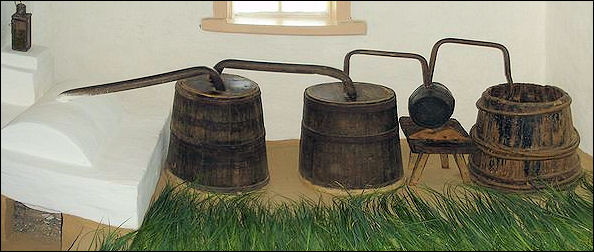
Ukrainian vodka still
Gaining access to the Kristall vodka factory requires government approval;. Describing it, Erof eyev wrote: the inside “has the sublime atmosphere of a cathedral. It is absolutely sterile. There is almost no smell of alcohol, and the employees wear white coats. The vodka is produced in a specialized production line, developed in Italy and Germany, in which alcohol is mechanically mixed with water (taken from the main Moscow water supply but specially filtered), and then the vodka is bottled, sealed and packed in boxes. Most of the machine operators are women, because, as my female guide told me, women are more suite for monotonous work.”
In the United States most vodka is made with neutral spirits that have already been distilled from grain from large Midwestern companies like Archer Daniels Midland. The spirits, 95 percent alcohol or more, are trucked to factories where they are mixed with water, filtered, processed with a few additives and bottles.
Stolichnaya, Russia's most famous brand of vodka, is produced by the Kristall, In 1996, the Russian Patent Office ruled Stolichnaya was a generic name that all the country's 150 alcohol factories can use. Many Russians have turned away from Stoli in favor of foreign and other Russian brands because they are no longer sure what's in the bottle. PepsiCo is the exclusive importer of Solichnaya to the United States.
Stolichnaya and Russian Produced Vodka
Stolichnaya, Russia's most famous brand of vodka, is produced by the Kristall, In 1996, the Russian Patent Office ruled Stolichnaya was a generic name that all the country's 150 alcohol factories can use. Many Russians have turned away from Stoli in favor of foreign and other Russian brands because they are no longer sure what's in the bottle. “Moskovaya” is flavored slightly with sodium bicarbonate. “Stolichnaya” is sweetened with sugar.
PepsiCo is the exclusive importer of Solichnaya to the United States. Although the vodka they sell is produced from carefully selected factories Pepsi Co is worried about the effect that Stolichnaya’s plummeting sales and reputation in Russian will have on overseas sales. SPI Ltd produces and distributes Stolichnaya vodka.
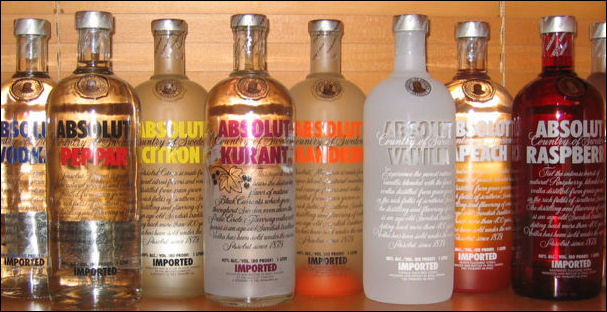
Absolut vodka flavors
Foreign brands of vodka like Absolute and Smirnoff are becoming more popular. Trendy brands n the United States include the French-made Grey Goose and the Dutch-made Ketel One.
The Russian government is trying to re-nationalize the vodka industry and take back the Stolichnaya trademark. The Russian agriculture ministry has ruled the government still owns the trademark. Lawyers with SPI lobbied American lawmakers to get them to support the denial of WTO membership for Russia until the matter was straightened out.
Smirnoff in Russia
Smirnoff vodka, the world's largest selling vodka and the top seller in the United States, was founded by Pyotry Smirnoff, vodkamaker of the tsars before the 1917 Bolshevik Revolution. The right to the Smirnoff name is now owned by the American company Heublin, which in turn is owned by the London-based giant Grand Metropolitan, the maker of Guinness Stout.
Heublin bought the name from a Russian emigre who in turn it bought it from a relative of Pyotry's son after the Smirnoffs emigrated to Poland after the Bolshevik Revolution in 1917 and ended up in France. Smirnoff was introduced to the United States in 1934 and became the best selling brand with the slogan “It will leave you breathless.” The red and blue labels of Smirnoff vodka sold in Russia read "successors of the world-famous PIERRE SMIRNOFF, MOSCOW, RUSSIA, Purveyors of the Czars."
When Hueblin began plans to market Smirnoff in Russia and tried to register the Smirnoff name, the company found they had been beaten to the punch by Boris Smirnoff, a relative of Pyotry, who registered the name three weeks before. Claiming it was downright un-Russian for a foreign-owned conglomerate to sell Smirnoff vodka in Russia, Boris began producing his own version of Smirnoff vodka.
Hueblin tried to settle with Boris by offering him a $100,000-a-year job, a lump sum of $2.5 million and stock in the Russia-based Smirnoff operation but at the last minute he reneged on the deal because he didn't want to be "bought." In January, 1994, state vodka factories began producing 100,000 bottles a month of vodka with Boris's Smirnoff's label.
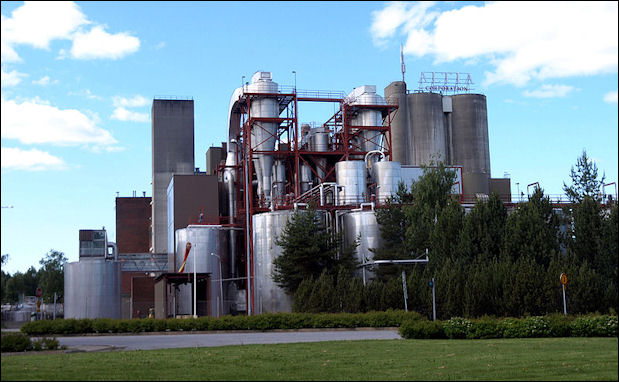
vodka factory
Cheap Foreign Vodka in Russia
In the mid-1990s, Russia was flooded with cheap foreign brands of vodka, mostly from Belarus and the Ukraine, that sold for as little as $2 a bottle, so cheap that many people substituted vodka for windshield-wiper fluid. The Russian alcohol industry lost about 50 percent of its market between 1993 and 1995 and the production at licensed distilleries dropped to 43 percent of capacity.
In one of his first moves after recuperating after heart surgery, Russian President Boris Yeltsin authorized an "emergency" law to raise taxes on imported alcohol in an effort to raise government revenues and stem the flow of foreign vodka. The new legislation set minimum prices at $1.90 per bottle for domestic vodka and $4.15 a bottle for imported vodka and imposed quotas to protect the domestic vodka makers.
One of the ironies of the law is that the foreign alcohol began pouring in after Yeltsin gave political cronies, such as his former tennis coach, permission to import alcohol without paying taxes or duties
Around 100 truckers carrying vodka were trapped in no man lands between Russia and Georgia after Russian border guards began enforcing a law restricting alcohol imports. The vodka was not produced in Georgia, which is the main entry point for vodka exported from the United States, Europe and Canada.
Illegal Vodka in Russia
It is estimated that one out of every two bottles of vodka produced in Russia is illegally made. In one survey, authorities found around 1,400 illegal distilleries, compared to 120 licensed one. Babushkas sell illegally-produced vodka by the bottle on the streets.
In one ingenious scheme that reaped huge profits and avoid paying millions of dollars in taxes, tens of millions of gallons of 192-proof grain alcohol was purchased in the United States, disguised with dye and shipped in containers marked as windshield wiper fluid, cologne, mouthwash and cleaning solvent. After it was smuggled into Russia, dye-removing chemicals, water and vodka flavoring were added and the liquid was sold as vodka.

Image Sources: Wikimedia Commons
Text Sources: National Geographic, New York Times, Washington Post, Los Angeles Times, Smithsonian magazine, Natural History magazine, Discover magazine, Times of London, The New Yorker, Time, Newsweek, Reuters, AP, AFP, Lonely Planet Guides, Compton’s Encyclopedia and various books and other publications.
Last updated March 2011
